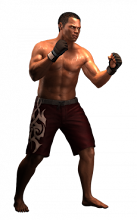Boxers who use an upright stance protect their chin with the rear hand in either the low or mixed guard styles depicted below. Crouch fighters tend to use the "peek-a-boo" style, discussed below.
| Low guard |
| Mixed guard |
| Peek-a-boo |
 |
| Mike Tyson |
Philly Shell, hitman or crab – The lead arm is placed across the torso usually somewhere in between the belly button and chest and the lead hand rests on the opposite side of the fighter's torso. The back hand is placed on the side of the face. The lead shoulder is brought in tight against the side of the face. This style is used by fighters who like to counterpunch. To execute this guard a fighter must be very athletic and experienced. This style is so effective for counterpunching because it allows fighters to slip punches by rotating and dipping their upper body and causing blows to glance off the fighter. After the punch glances off, the fighter's back hand is in perfect position to hit his out-of-positioned opponent. The shoulder lean is used in this stance. To execute the shoulder lean a fighter rotates and ducks when his opponent's punch is coming towards him and then rotates back towards his opponent while his opponent is bringing his hand back. The fighter will throw a punch with his back hand as he is rotating towards his undefended opponent. The weakness to this style is that when a fighter is stationary and not rotating he is open to be hit, so a fighter must be athletic and well conditioned to effectively execute this style. To beat this style fighters like to jab their opponent's shoulder causing the shoulder and arm to be in pain and to demobilize that arm.
Boxers generally attempt to land high, fast combination and then quickly shift position to avoid a possible response by their opponent. Strategically, the ring's centre is generally the desired position since a boxer is able to conserve movement by forcing the opponent to circle around them. When in the centre, the boxer is also less likely to be knocked backwards against the ropes surrounding the ring and cornered. Depending on the boxer's style, the centre is the desired location as cornering opponents is always a good strategy. Most fighters, though, will not move around the boxer in the center because doing so makes them vulnerable to shots thrown at good angles. Movement is the most important tool in the ring and allows the fighter to avoid punches that were not telegraphed. If a boxer is standing still, his opponent has a better chance of hitting him. A fighter anticipating a shot while stationary is less likely to be able to evade the shot than a fighter already in motion.
Source: http://en.wikipedia.org/wiki/Boxing
MMA Pro Fighter



